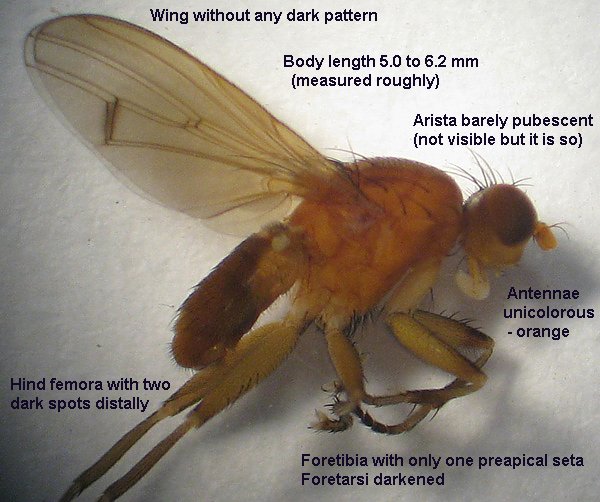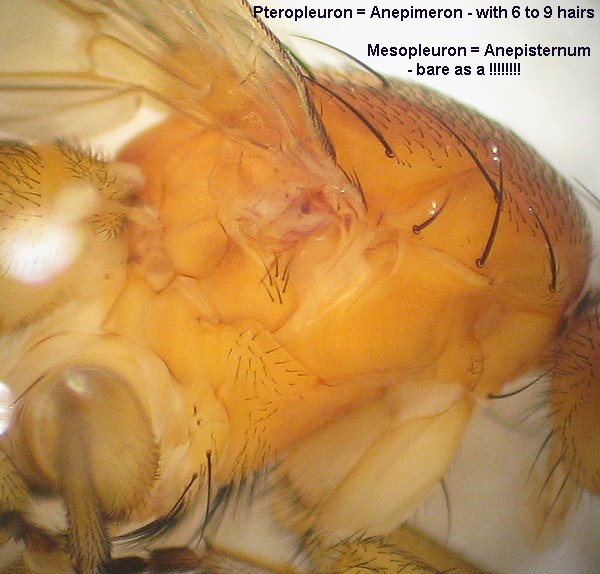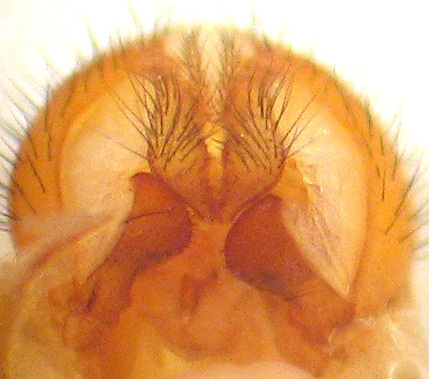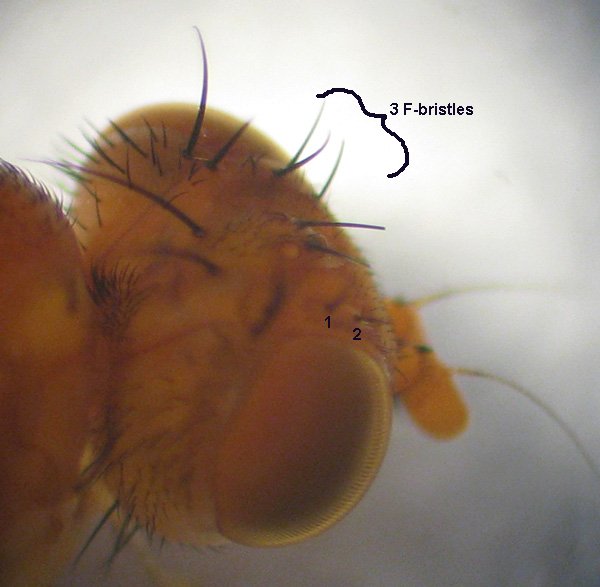Diptera.info :: Identification queries :: Diptera (adults)
|
Sciomyzidae: Pherbellia sp
|
|
| Gordon |
Posted on 09-11-2008 16:45
|
|
Member Location: Lake Kerkini, Greece Posts: 1101 Joined: 02.01.08 |
OK you experts, time to get your key out. I think everything you need is here but if not ask, I have dozens of them. So the location is Kerkinis Mts of Northern Greece, from 630 to 1500 metres, dates between June and November. I have checked a number and the colouration of the thorax is quite variable, from uncolorous blackish to light brown with longitudinal lighter stripes - however the male genitalia are the same for both colour forms as are all other characters I have checked. The size range is 5.0 to 6.2 roughly measured with a ruler under the petri-dish, I have no graticule sorry. If you need another view ask. Now I must stand up and take my punishment as a hypocrit because I am going to post three photos, sorry. Gordon attached the following image:  [67.81Kb] |
| Gordon |
Posted on 09-11-2008 16:47
|
|
Member Location: Lake Kerkini, Greece Posts: 1101 Joined: 02.01.08 |
Now a closer view of the side of the thorax.
Gordon attached the following image:  [77.9Kb] |
| Gordon |
Posted on 09-11-2008 16:51
|
|
Member Location: Lake Kerkini, Greece Posts: 1101 Joined: 02.01.08 |
Finally those all important male reproductive organs.
Gordon attached the following image:  [118.7Kb] |
| Paul Beuk |
Posted on 10-11-2008 10:20
|
|
Super Administrator Location: Netherlands Posts: 19403 Joined: 11.05.04 |
I cannot really say much now. I'd need to have both the Rozkosny 1984 and 1987 keys and I only have a photocopy of the 1987 one at hand now. The latter only illustrates some of the genitalia. From the above pictures I cannot exclude Ditaeniella (which I don't know). Following the 1987 key it might be P. annulipes...
Paul - - - - Paul Beuk on https://diptera.info |
| Gordon |
Posted on 10-11-2008 12:16
|
|
Member Location: Lake Kerkini, Greece Posts: 1101 Joined: 02.01.08 |
Dear Paul, It is not really necessary that you say something, I was just hoping somebody would say something. I would write to Rozkosny but he is getting old and never answers my emails so now I don't bother. It can't be Ditaeniella, see new photo, because of the 2 (3 in this case on the left hand side  ) F-bristles. Not visible I admit in the first photos because one was broken off. My mistake. ) F-bristles. Not visible I admit in the first photos because one was broken off. My mistake.
Gordon attached the following image:  [42.11Kb] |
| Gordon |
Posted on 10-11-2008 12:24
|
|
Member Location: Lake Kerkini, Greece Posts: 1101 Joined: 02.01.08 |
With reguard to P. annulipes, like you I have only a photocopy of the 1987 key, (with images missing 375 to 394) but this does not show the genitalia of P. annulipes. Nevertheless my specimens would mostly be too big, and see photo no.4, there are no rings on the hind and mid tibia and femur. Merely the spots on the hind femur. So we wait for somebody who knows more, or at least has more literature. Gordon attached the following image:  [77.9Kb] |
| Nikita Vikhrev |
Posted on 10-11-2008 13:19
|
|
Member Location: Moscow, Russia Posts: 9500 Joined: 24.05.05 |
Ditaeniella has hairy mesopleuron. Neither Ph.annulipes - small species, withdark ringed tibiae. 99% It is Pherbellia scutellaris (von Roser 1840) Nikita Nikita Vikhrev - Zool Museum of Moscow University |
|
|
|
| Gordon |
Posted on 10-11-2008 14:17
|
|
Member Location: Lake Kerkini, Greece Posts: 1101 Joined: 02.01.08 |
Thanks for the comments Nikita, Ph. scutellaris was my first choice, but on studying the genitalia diagrams in the Rozkosy key I became convinced that it looked more like Ph. rozkosnyi, which of course is too small. Also to get to either of these in the key you have to say the mesopleuron has 2 distinct bristles and some hairs, yet in all the specimens the mesopleural hairs are the same size, only the number varies. Would you be able to be certain if I sent you a couple of specimens, I have about 35, and probably more in unsorted materials, so I can afford to share a few. Gordon |
| Nikita Vikhrev |
Posted on 10-11-2008 14:45
|
|
Member Location: Moscow, Russia Posts: 9500 Joined: 24.05.05 |
Ph. rozkosnyi and Ph. scutellaris is closely related species, may be even a synonim, Ph. scutellaris is much older name, so in doubts - Ph. scutellaris. I'll be glad to examen specimens. Males, please  Nikita Nikita Vikhrev - Zool Museum of Moscow University |
|
|
|
| Jump to Forum: |













